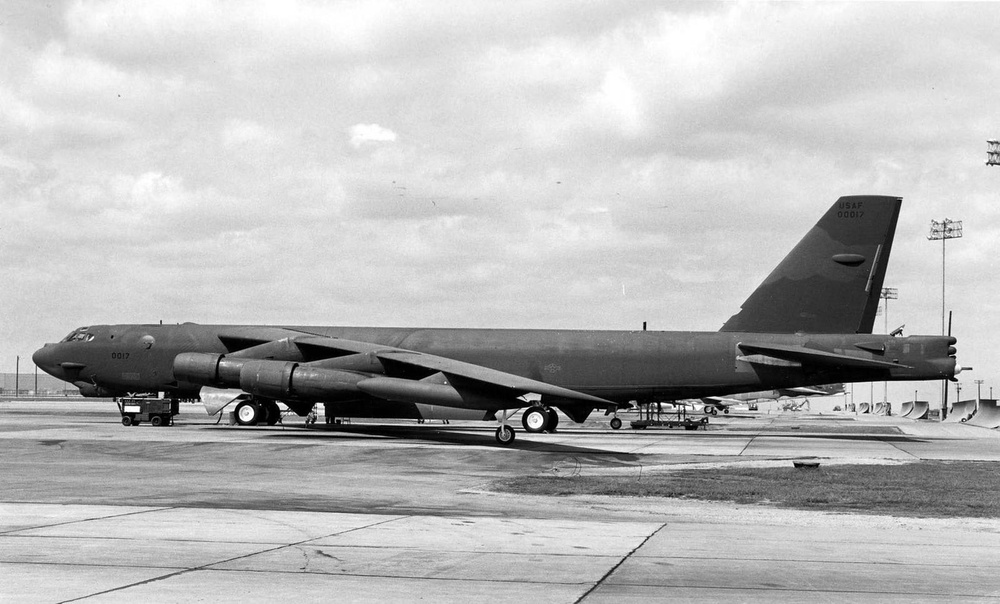U.S. CENTRAL COMMAND AREA OF RESPONSIBILITY – Since its inaugural flight in 1952, the B-52 Stratofortress has continuously proven its role as Air Force Global Strike Command’s most versatile long-range heavy bomber. Over the years, the B-52 has been adapted and improved to meet the ever-changing needs of the global defense environment, flying in operations that span the globe.
After WWII, Air Materiel Command expressed a desire for a new strategic bomber with long-range mission capability that could operate independently of foreign bases. On May 9, 1961, the first B-52 landed at Wurtsmith Air Force Base, Michigan, in response to that desire. By the time production ended in 1963, nearly 750 B-52s were built.
One B-52 in particular, with the tail number 60-0017, was assigned to the 379th Bombardment Wing at Wurtsmith AFB on June 17, 1961. Now, almost 63 years later, the same aircraft has flown out of the 379th Air Expeditionary Wing, 6,988 miles away, as a part of the same wing at Al Udeid Air Base. Airframe 60-0017 is a testimony to the lasting success and enduring utility of the B-52, having made a significant contribution to warfare in a consistently changing defense environment.
The 379th AEW finds its origin in the early days of World War II, when the Army Air Corps activated the 379th Bombardment Group, Heavy on Nov. 3, 1942. After three years of distinguished service, flying primarily bombardment operations against strategic targets in Europe, the group was inactivated on July 25, 1945.
Over 82 years, the 379th has evolved multiple times. In November 1955, the Air Force activated the 379th Bombardment Group, Medium. In January 1961, the unit was redesignated as the 379th Bombardment Wing, Heavy. At this time, the B-52 was introduced to the wing at Wurtsmith Air Force Base. The 379th Bombardment Wing was inactivated on June 30, 1993, and was reactivated by the Air Force on April 2, 2002, as the 379th Air Expeditionary Wing.
The B-52 has demonstrated remarkable flexibility, proving effective in a variety of roles, including strategic bombing, close air support, and maritime operations. With an impressive range that allows it to survey up to 140,000 square miles of ocean within two hours, the B-52 proved to be a key strategic asset during the Cold War.
It has served as a looming deterrent in the skies against conventional conflict with its long-range capabilities and nuclear payload potential. At the introduction of the Vietnam War, the B-52 transitioned from a nuclear deterrent role to a conventional bombing role, showcasing its adaptability. The aircraft was also essential in targeting enemy positions across Southeast Asia during notable operations like Operation Arc Light and Linebacker II.
Since the 1960s, the B-52 has consistently demonstrated the value of its original innovative design, combined with the successful integration of top-of-the-line technology, as exemplified by airframe 60-0017. It remains a constant symbol of deterrence in the skies, contributing to global stability and security as it continues to fly operations today.
| Date Taken: | 02.01.2025 |
| Date Posted: | 02.01.2025 03:57 |
| Story ID: | 489914 |
| Location: | (UNDISCLOSED LOCATION) |
| Web Views: | 12 |
| Downloads: | 0 |
PUBLIC DOMAIN

This work, A B-52 reconnects with the 379th, by A1C Robert Nichols, identified by DVIDS, must comply with the restrictions shown on https://www.dvidshub.net/about/copyright.







